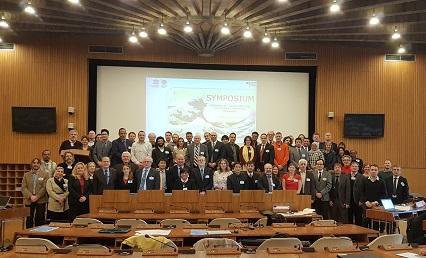
Participants at the Second International Tsunami Symposium hosted by UNESCO, IOC in Paris (photo: UNESCO/IOC)
By Brigitte Leoni
PARIS, 14 February, 2018 - More needs to be done to reduce response times to tsunami alerts and and to improve wave height measurement if progess is to be made on reducing mortality from tsunamis, an international gathering of experts heard this week.
Speaking at the Second International Tsunami Symposium, François Schindelé, from the French National Tsunami Center (CENALT) said: “Since the creation of the Indian Ocean Tsunami Early Warning in 2005, considerable progress has been made in terms of tsunami detection and monitoring technologies, awareness and education but much more needs to be done to reduce the time response and the accuracy of messages delivered to the civil protection agencies and emergency responders. We also need to better predict the height of tsunami waves, their run up and how far inland they would flood to save more lives in the future.”
The symposium is hosted by UNESCO’s Intergovernmental Oceanographic Commission (IOC) to discuss the latest developments in tsunami early warning research and technologies to better protect millions of people at risk of tsunamis.
Since the year 2000, more than 11 million people have been affected by tsunamis and more than 250,000 persons lost their lives.
Over 100 seismologists, researchers, representatives of civilian protection authorities, operational centres, national monitoring and prevention services are assessing the successes and limitations of current warning systems in past tsunamis, the role of traditional media and social media in alerting the public what information is needed for effective community response.
Participants highlighted the need for science to work more closely with emergency responders and policy makers, and how education and public awareness are essential to better protect coastal communities ntoing that many communities will be at even greater risk of tsunami and floods with sea-level rise.
Vladimir Ryabinin, IOC Executive Secretary, opened the Second International Tsunami Symposium, and referenced the global plan for reducing disaster losses, the Sendai Framework for Disaster Risk Reduction, adopted three years ago by UN member States.
“We still have a long way to go before achieving Target G of the Sendai Framework which aims at substantially increasing the availability of multi-hazard early warning systems and disaster risk reduction policies by 2030 but we are moving ahead and making considerable progresses” said Mr. Ryabinin.
He highlighted the importance of rethinking early warning systems in the lead up to the UN Decade of Ocean Science for Sustainable Development 2021-2030.